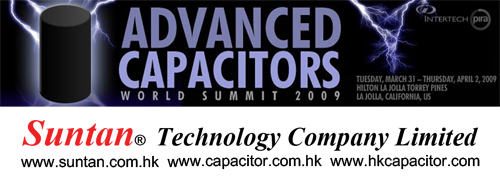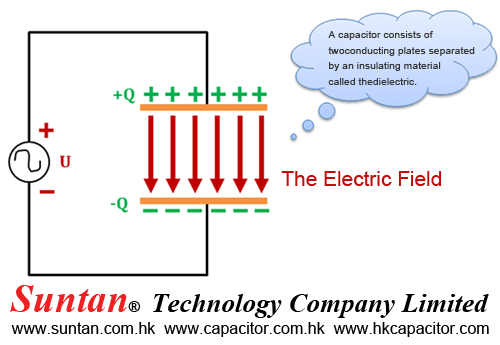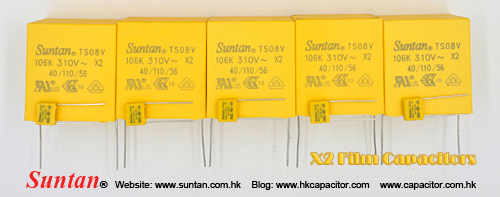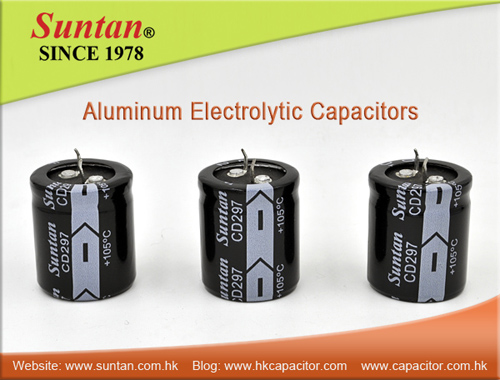Suntan Technology Company Limited
---All Kinds of Capacitors
Advanced Capacitors World Summit 2009Final program confirmed featuring the latest in industry developments, applications and technology PORTLAND, Maine, January 6, 2009 —IntetechPira, a leading conference and research organization is pleased to announce the final program for the 7th annual Advanced Capacitors World Summit 2009 set for March 31 – April 2, 2009 at the Hilton Torrey Pines in La Jolla, CA, US.
Co-Chaired by Richard Smith, ANA Strategic System Group and Andrew Burke of the University of California Davis Institute of Transportation Studies, this year’s program is designed to help current and prospective users, integrators and suppliers of advanced power systems understand modern energy storage and delivery challenges for power intensive applications and identify business opportunities and realities with adopting advanced capacitors and capacitor hybrid systems to solve application energy requirements. Speakers will discuss the latest market trends and developments, power engineering and integration strategies, design and business implications and costs associated with advanced power systems for various applications, including transportation, automotive, power and consumer electronics and renewable energy.
Market Overview and industry developments:
Bobby Maher of M Cubed Consulting will start off the program with a comprehensive overview of ultracapacitor market trends and technology advancement and David Alexander from IVUS Energy Solutions, creator of the patented FlashPoint Power Technology, will address serious challenges that arise when developing capacitors for the market. Andy Burke of UC Davis will provide an engaging comparison of ultracapacitors and advanced battery technology in terms of performance, cost and versatility, while John Miller of Maxwell Technologies will show how the two technologies can be best applied in tandem. A panel presentation from members of the investment community will conclude the morning session and will provide insight on how to secure funding in uncertain economic times.
John Skibinski of Eaton Corporation will shed light on the growing demand for advanced energy storage technologies for wind and solar applications. Speakers from Volvo Technology Corporation, General Electric and NREL will discuss engineering energy storage systems for hybrid electric vehicles and heavy hybrids. Aerospace applications will be explored with presentations from Lockheed Martin Aeronautics and company partner PC Krause and Associates and additional new and emerging applications will be covered by Jin Song of Nesscap.
Olgierd Paluskinski of the University of Arizona and M Grant Norton of GoNano Technologies will discuss the latest work with improving the energy density of capacitors. Paluskinski will also discuss how his group has used nanotechnology to achieve better performance and reduced cost for photovoltaics applications serving to reduce fluctuations in output power while increasing conversion efficiency. Yuri Maletin of APowerCap Technologies will reveal how nano-engineered capacitors using inexpensive nanoporous carbon material can lead to improved performance, while reducing cost, in automotive, hand-tools, energy quality and power management applications and systems.
Applications and technology:
Additional presentations from ISE Corporation, Ionix Power Systems LLC, Sigma Technologies International, Rockport Capital and Battery Ventures will also be featured.
As one of the worlds leading forums for discussing the latest technical advances and market trends in the EC industry, IntertechPira’s Advanced Capacitors World Summit 2009 is a dynamic industry event, providing a unique opportunity to gain the necessary knowledge and network with global leaders from around the world.
For complete program details and registering options, please visit: www.advancedcapacitorsws.com
Members of the press interested in attending, to find out if you qualify for a complimentary press pass, please contact Press Officer Sheri Bonnell at sheri.bonnell@pira-international.com or +1 207 781 9637.





